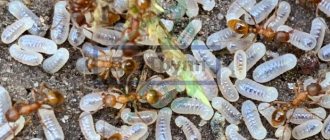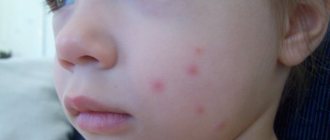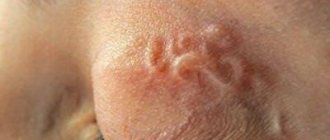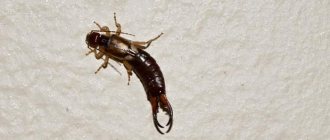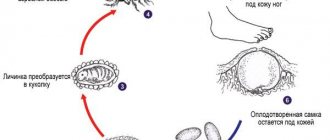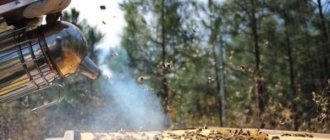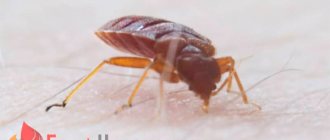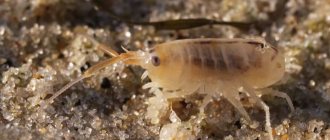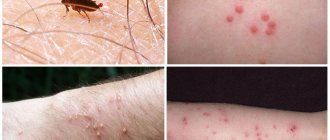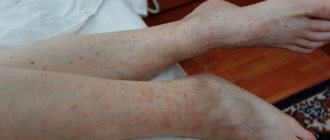Views: 1,993
Very often people confuse insects such as horseflies and gadflies . Both look like flies. Both are parasites that attack animals and humans. However, the harm they cause is different . They attack differently, live and look differently... What is the difference between horseflies and gadflies? You can read about the difference between them in the article What are the consequences of a horsefly bite? There we touch upon the moment. And in this article we will take a closer look at what an insect such as a gadfly is, and what a “bite” of a gadfly is.
Bitten by a gadfly? Come on!..
Human gadfly
If, after an insect attack, a bite mark remains on the skin, then it was NOT a gadfly) The fact is that the mouthparts of gadflies are reduced. That is, underdeveloped. In principle, they cannot bite anyone , since they have nothing with which to bite. Adults do not feed at all. They are engaged only in reproduction and reproduction of offspring. And they are in a hurry, since parasites live for a very short time.
But the carnivorous larvae of gadflies cause a lot of trouble to both people and animals. They penetrate the tissues of the victim's body and develop there, causing itching, destroying the body and causing suffering . What does a gadfly do when it sees a suitable food item? It lays its eggs on the surface of the victim's body (and some representatives do this on the fly!) Some of the eggs are attached to hairs on the skin.
Very soon, worm-like hungry offspring hatch from them , which invade the host’s body and begin to eat through the passages in it . This continues until the gadfly larva grows to the desired size. After this, it falls to the ground and enters the pupal stage, beginning further development.
General information about horseflies
Horsefly
A simple person who does not have serious knowledge of biology cannot distinguish a gadfly from a horsefly, which belongs to the order Diptera, but knows that the bite of a gadfly can be painful, so he is afraid of such an insect. The horsefly is a blood-sucking parasite. It lives in forest, taiga, forest-steppe zones. In arid areas, the insect can be found mainly near rivers and lakes; in the mountains it spreads to the borders with eternal snow.
Horseflies are popularly called gadflies. Only fertilized females, who need blood for the development of eggs, bite humans and animals. Males are smaller in size and feed on plant nectar. Females have a proboscis in their mouthparts, with which they cut the skin of the victim and inject substances into the wound that prevent blood clotting.
The length of the insect ranges from 6 to 30 mm. The color of the wings is gray, marbled, or it can be variegated. Bloodsuckers fly in good weather without rain or wind. The air temperature should not be lower than +15, but not higher than +32 degrees. Outside these temperature limits, bloodsuckers are inactive.
On a note!
The most common representatives in our country are rainflies, lacewings and horseflies. They show noticeable activity before the rain, but in wet weather you will not see them. Only rainflies can attack humans even during light precipitation.
Gadfly - an insidious insect
Subcutaneous gadfly
To imagine what a gadfly looks like, look at the photo next to it. Different types may differ from each other. Some are more like bees or bumblebees, others more like flies. What they have in common is that the body is more or less noticeably pubescent (unlike horseflies). Although there are exceptions (like the human gadfly). Well, what gives them away is their specific parasitic lifestyle that they lead.
We have already explained above why gadflies are dangerous. The results are especially disastrous when parasites settle in internal organs. Including in the brain. Yes, these aggressors can even crawl there. As a result, they not only harm health, but also threaten the lives of people and animals. There are known cases of death due to the penetration of the gadfly larva into the brain . If parasites take root in the eyes (this, unfortunately, also happens), then this can often lead to partial or complete loss of vision.
According to the place of parasitism of the larvae, the following types of gadflies are distinguished (photo in the article):
Equine gastric botfly
- Subcutaneous
- Gastric
- Nasopharyngeal
Moreover, in different types of parasites, the larvae penetrate the host’s body in different ways. Subcutaneous gadflies lay eggs on the skin or hair of an animal . After hatching, the larva gnaws its way into the victim's body. Individuals of gastric botflies can lay eggs in the grass or on the fur of ungulates - in a place where the animal can lick off the future offspring. This is how the parasites enter his digestive system, and the larvae begin their harmful activities. Some nasopharyngeal gadflies immediately “scatter” live larvae . They settle their young in the nose and mouth of mammals. Once at their destination, the predatory, agile larvae quickly penetrate the mucous membranes and begin to settle there .
Complications
Tachycardia, nervousness, excessive anxiety, breathing problems, inability to concentrate are possible symptoms after a gadfly bite.
In such cases, it is necessary to administer antitoxic drugs containing immune serums.
It is also worth using diuretics and glucocorticoid hormones. If necessary, antishock drugs are administered.
A bitten person may be hospitalized for more than a week; vitamin complexes and special diets are prescribed to normalize metabolic processes. They also increase immunity.
Where do gadflies live?
Almost everywhere . And, as a rule, where people live. These parasitic flies belong to the so-called synanthropic species. Their life activities are closely connected with human society.
The most aggressive and sophisticated types of gadflies are found in hot countries. There are several times more cases of these insects attacking people. In this case, parasites can lay eggs not only on the human body, but also on clothing . This is often enough for the quickly hatching larva to instantly bite into the body of its host.
In the tropics of America there is a gadfly that lays eggs on mosquitoes (!). The larvae develop inside the eggs for several days. And as soon as a mosquito lands on a warm-blooded animal, they immediately hatch and migrate to the skin of people and animals.
Reindeer gadfly
Gadflies manage to survive even in the extreme north . So, in the spring and summer they fly in a northerly direction, covering enormous distances. And for what? To find herds of reindeer. The larvae of these gadflies crawl under the skin of animals and develop there until the onset of winter. And when the herds are moved south, where it is much warmer, the parasites fall into the ground and finish their development.
Prevention
Taking precautions will reduce the likelihood of encountering stinging insects.
- Nature is full of all kinds of living creatures, so when going on vacation, take insect repellents with you.
- When walking in the forest and other green areas, try not to touch bushes, grass and other greenery with your hands.
- Wear closed clothing when going outdoors.
- Do not leave food uncovered or dishes dirty.
- If you notice an insect near you, do not make sudden movements, try to calmly move away.
- Do not use sweet scents in summer, they attract many parasites.
- Don't sleep outdoors in the summer without treating the area or your skin with a repellent. Otherwise, you may be attacked not only by gadflies, but also by other pests.
- Always take a first aid kit with you, including antihistamines.
The bite of a gadfly is dangerous for humans, especially children. Never ignore it, but take immediate action. If everything is done correctly, there will be no serious consequences. The wound will quickly heal without leaving a trace.
Means of protection against gadflies
People's fight against these insects has been met with varying degrees of success . And it seems that it will not be possible to completely get rid of the gadfly invasion. They are too unceremonious and resilient. However, you can reduce their attacks to a minimum:
- First of all, it is important to use repellents that repel persistent flies. The choice in modern stores is now extensive. Buy either creams or aerosols. Some of the remedies for gadflies, for example, OFF spray, last up to 4 hours after application . The main thing is to act according to the instructions and take into account contraindications.
- For lovers of natural products, there are various insect repellent aerosols and creams containing essential oils. They contain substances of strong-smelling plants, the smell of which flying and other insects cannot tolerate . Can be applied both to the skin and body. The list of contraindications for such products is usually smaller than for chemical drugs. However, it is worth considering that they often do not last as long as “chemistry”.
- To massively reduce the number of gadflies (and other parasites) in meadows and pastures, it is recommended to carry out pest control treatment of the area . Preparations based on pyrethroids . They destroy not only insects caught under a cloud of toxins, but also, most importantly, eggs and larvae of pests.
- From the moment subcutaneous botflies lay eggs on the skin and fur of animals or human clothing, 4-6 days pass until the larva hatches. Therefore, it is important to immediately wash clothes that were used for hiking. And of course, wash thoroughly (including your head) after returning from a summer vacation) This will wash away the parasite eggs, preventing them from developing and hatching.
, collected in the meadow. In this case, it is especially important to monitor children who, out of habit, put everything in their mouth. AND wash your hands before eating, no matter how trivial it may sound! Many parasites enter the digestive tract from dirty hands.
Don't lick blades of grass- If you find yourself near a river, then its waters can be a temporary solution to escape from annoying gadflies. Insects do not touch those who are in the pond . Of course, you won’t be able to sit there all the time. But you can take a temporary break and think about how to quickly get away from an inappropriate place.
- To protect animals from gadflies, there are products specially developed by veterinarians. They are applied to the skin of animals. There are also various means for disinfecting areas affected by gadflies. They are sprayed onto the surface of the animal's body.
- Use various traps to catch insects. Many of them can be made with your own hands. And if the “bites” of gadflies and horse flies don’t give you peace, then it makes sense to either make a mechanical trap yourself or buy a ready-made one. It is also worth paying attention to various insecticidal light lamps designed to attract and destroy gadflies and other flying pests. In some of them, insects are killed using a small current, i.e. electrical discharges.
Both eggs and larvae of gadflies, as well as the adult parasites themselves, hide in cool, dense vegetation. Therefore, do not leave refuge for aggressors!
Regular grass mowing is required on the property.- In your summer cottage or garden, avoid open containers with water. Almost all insects love water. And any reservoir where there is moisture becomes a breeding ground for many pests. This must be taken into account when organizing artificial reservoirs on the territory or outdoor pools. It is advisable to cover water tanks with lids.
As you can see, there are many options. And the best thing is to use several approaches at once . Then it is much easier to get rid of the gadflies. Well, try to go out into nature less on hot summer days, when the area is infested with gadflies, horse flies and other parasites. And if you can’t do without it, then wear thick, light-colored clothes . It has been noticed that gadflies and horseflies often stick to dark colors. They like lighter shades less. And if the fabric of the clothing is thick enough, then they will not be able to bite through it. And the larvae of gadflies will remain without access to the host’s body.
Treatment
After being bitten by a parasitic fly, the victim should be given first aid. If there is no car with a first aid kit nearby, you will have to do without disinfectant solutions and antispasmodics. If there is free access to pharmacological drugs, recovery can be significantly accelerated.
Recipes from traditional healers
Many folk remedies for gadfly bites are right under your feet. Medicinal herbs have anti-inflammatory, antimicrobial, antiseptic properties. This is exactly what is necessary to provide first aid for any insect bites. The most effective ways to prevent infection include the following folk remedies:
- Plantain leaves. The young plant must be crushed to a thick paste and applied to the bite site, and after the product has dried, the procedure should be repeated. Plantain contains biologically active substances that reduce the severity of pain and prevent the development of edema;
- Dandelion leaves. Fresh leaves need to be mashed a little, applied to the bite site and secured with a bandage. Dandelion exhibits antiseptic and anti-inflammatory activity and is able to stop the spread of infection.
You can do without medicinal plants. What to do if you are bitten by a gadfly and there is no medicine at hand:
- dilute a teaspoon of soda in a glass of water, soak a bandage in the solution and apply to the site of the gadfly bite;
- treat the damaged area of skin with sour cream or freshly squeezed tomato juice;
- place ice in a plastic bag, wrap it in a thick cloth and apply to the bite area for 10 minutes.
A compress of grated fresh potatoes effectively eliminates swelling of all layers of the epidermis. You can lubricate the bite site with low-fat sour cream, kefir, and valerian tincture.
“Warning: It is inappropriate and even dangerous to try to squeeze out insect saliva. The fly makes such a thin puncture that at best a small drop of blood will appear from the hole. Strong pressure will only accelerate the penetration of pathogenic bacteria into soft tissues.”
Pharmacological drugs
If an insect attacks a person while hiking or gardening, you need to use disinfectant or antiseptic solutions that are in any first aid kit. How to anoint a gadfly or horsefly bite:
- 3% hydrogen peroxide;
- alcohol solution of chlorhexidine bigluconate;
- brilliant green solution;
- alcohol solution of iodine;
- a slightly pink solution of potassium permanganate.
Ethyl alcohol, and even regular vodka without additives, will help prevent the spread of infection and reduce the severity of swelling. The victim should definitely be given a tablet of any antihistamine:
- Suprastin;
- Tavegil;
- Loratadine;
- Cetrin;
- Zyrtec.
To quickly eliminate the symptoms of general intoxication (chills, fever, pain), you can use non-steroidal anti-inflammatory drugs. How to treat a gadfly bite with NSAIDs:
- for adults, take a tablet or capsule of Ibuprofen, Nise, Nimesulide;
- Give the child a teaspoon of syrup or suspension of Ibufen, Nurofen.
If there are no such products in the medicine cabinet, then regular Paracetamol in tablets or syrup will help reduce the temperature and relieve pain.
“Recommendation: If the bite site has festered, is very swollen and red, then you should immediately consult a doctor. He will prescribe drugs with antibacterial activity to destroy pathogenic microorganisms.”
What else needs to be taken into account in the fight against gadflies?
An unusual pattern is often observed in the behavior of gadflies. The adults all emerge from their pupae at once , as if on schedule. Moreover, they also do this at certain times of the day. In the middle zone - most often from half past eight to half past eight in the morning . Therefore, it is not surprising that at one moment a whole swarm of these parasitic flies swoops in at once .
Of course, nature has provided such a mechanism so that females and males can find each other to procreate. However, this fact can also be used to combat gadflies. In general, of course, if possible, you should not walk in meadows or near forest areas at this time, or take animals outside . Especially if it’s already hot in the morning. But also during this period it is best to carry out pest control treatments : insects emerge en masse from their pupae, although they have not yet had time to cause harm. This is where they need to be destroyed.
Preventive measures
There are a number of precautions you can take to avoid insect bites.
It is especially important to follow these tips if you are allergic to stings:
- Move slowly and don't panic if you encounter wasps, hornets or bees. Don't wave your arms.
- If you are going outside when insects are most active, such as sunrise or sunset, wear long sleeves and pants.
- Avoid walking without shoes outdoors.
- Apply insect repellent to exposed skin.
- Avoid using items with strong odors such as soaps, shampoos and deodorants as they may attract insects.
- Avoid flowering plants, places where food is served or where garbage is stored.
- Avoid resting near ponds and swamps. Dangerous insects are most often found near water.
- Keep doors and windows closed or install fine mesh to prevent insects from entering your home. Also keep your car windows closed.
- Don't break bee evidence. Find a professional to get rid of them.
Did you know that...
Bovine botfly
– Gadflies are one of the most energetic insects . They beat their wings about 345 times per second! Many of them need speed, maneuverability and agility in order to scatter their offspring on the fly to their future owners.
– Gadflies are very prolific . One female lays up to 2500 eggs. Why so much? Because the likelihood of eggs getting into the body of animals is quite small. Especially those gadflies that lay eggs on the grass in the hope that some animal will lick the vegetation.
– The larva of the subcutaneous gadfly can live in the integument of an animal for up to 9 (!) months . At the same time, she, gnawing her way, tries to crawl towards the back. There the animal will not be able to reach it or crush it by lying on the ground. As a result, a thick, painful nodule (up to 2 cm wide) forms under the skin as the carnivorous larva advances.
– Gadflies are extremely purposeful and persistent insects . They can pursue their chosen victim for hours until the victim gets tired and lies down to rest, exhausted. That's when they lay their eggs on tired animals.
– Many animals already recognize the buzzing of gadflies from afar and begin to run away in panic . At the same time, they unmistakably distinguish them from other flies, guessing the dangers of meeting these parasites.
– The survival of the eggs of some gadflies reaches 250 (!) days . That is about 8 months. Throughout this entire period, the larva that has developed in the egg calmly waits for favorable conditions. Namely, when for one reason or another it ends up on the body of its victim or is swallowed by it. Then she immediately hatches from the egg and proceeds to active action.
Nasopharyngeal gadfly
– Some animals have adapted to destroy gadfly larvae. This applies to those of them that parasitize in the nasopharynx. When the female insect injects the larvae with liquid into the animal's nose, it begins to kick up dust with its hooves to dry out the parasites. And often it works. But not with 100% probability.
– Gadflies are one of the most harmful insects . Including in our country. Therefore, we included them in our rating The most dangerous insect bites - TOP 10 in Russia
Possible consequences
Possible consequences of insect attacks include:
- Severe swelling of the damaged area of skin and surrounding tissues. The tumor quickly increases in size in the first hours after the bite, spreading to surrounding tissues. This happens due to the toxins contained in the gadfly’s saliva, which it injects when biting under the skin of the victim. As a rule, swelling is accompanied by severe itching, pain, and redness of the skin. If a person is allergic, swelling affects the entire limb or the area of injury. The most dangerous is considered to be a bite to the head; swelling spreads to the larynx, affecting the respiratory tract, which leads to suffocation.
- The appearance of nodes and bumps at the site of the bite. As a rule, such formations are painful. Over time, the nodes and bumps increase in size, causing great discomfort to the victim. The formation of nodes and bumps is a consequence of toxic insect saliva getting under the skin. As a result of the bite, insect eggs remain under the skin. Once mature, the eggs grow into parasites that can crawl out.
- Allergic reactions. Manifest in the form of rash, itching, swelling.
- Infection in the wound. This usually happens when a person scratches the bite area vigorously. Due to infection in the wound, it begins to fester.
- Swelling of the lymph nodes.
Depending on the characteristics of each individual person, the consequences of gadfly bites acquire varying degrees of severity. It all depends on the person’s age and whether he or she has chronic diseases. For some, there will be no trace of the bite the next day, while for others there will be serious consequences requiring medical treatment.
“Bite” of a gadfly – summing up
#1. So, gadflies don't bite . If there is damage to the skin after an insect attack, then it was not a gadfly that bit him, but some other arthropod.
# 2. Why are gadflies dangerous? Their larvae penetrate various tissues of animals and humans and develop there, destroying the body.
#3. Removal of gadflies , or rather their larvae, can only be done surgically. To do this, you need to seek appropriate medical care. In the case of animals, it is necessary to call veterinarians.
What else to read about insects:
– Physical methods of exterminating insects
– Prevention and control of bed bugs
– Cockroaches in an apartment: how to get rid of them?
